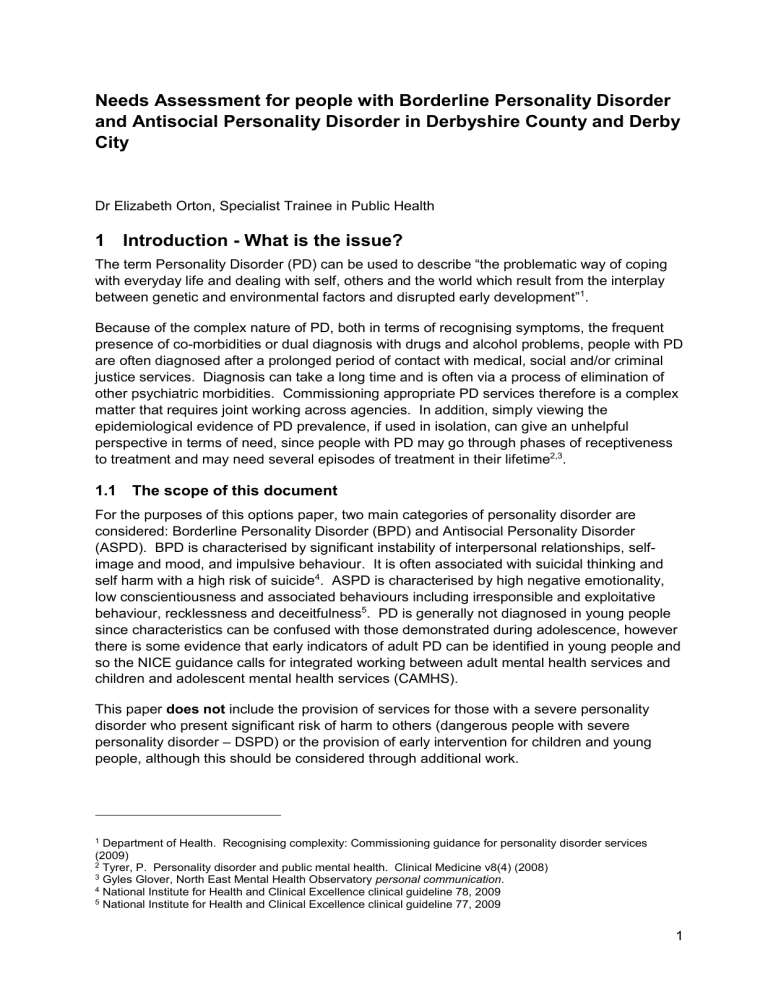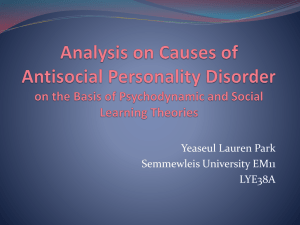3.2 Antisocial Personality Disorder (ASPD)
advertisement

Needs Assessment for people with Borderline Personality Disorder and Antisocial Personality Disorder in Derbyshire County and Derby City Dr Elizabeth Orton, Specialist Trainee in Public Health 1 Introduction - What is the issue? The term Personality Disorder (PD) can be used to describe “the problematic way of coping with everyday life and dealing with self, others and the world which result from the interplay between genetic and environmental factors and disrupted early development”1. Because of the complex nature of PD, both in terms of recognising symptoms, the frequent presence of co-morbidities or dual diagnosis with drugs and alcohol problems, people with PD are often diagnosed after a prolonged period of contact with medical, social and/or criminal justice services. Diagnosis can take a long time and is often via a process of elimination of other psychiatric morbidities. Commissioning appropriate PD services therefore is a complex matter that requires joint working across agencies. In addition, simply viewing the epidemiological evidence of PD prevalence, if used in isolation, can give an unhelpful perspective in terms of need, since people with PD may go through phases of receptiveness to treatment and may need several episodes of treatment in their lifetime2,3. 1.1 The scope of this document For the purposes of this options paper, two main categories of personality disorder are considered: Borderline Personality Disorder (BPD) and Antisocial Personality Disorder (ASPD). BPD is characterised by significant instability of interpersonal relationships, selfimage and mood, and impulsive behaviour. It is often associated with suicidal thinking and self harm with a high risk of suicide4. ASPD is characterised by high negative emotionality, low conscientiousness and associated behaviours including irresponsible and exploitative behaviour, recklessness and deceitfulness5. PD is generally not diagnosed in young people since characteristics can be confused with those demonstrated during adolescence, however there is some evidence that early indicators of adult PD can be identified in young people and so the NICE guidance calls for integrated working between adult mental health services and children and adolescent mental health services (CAMHS). This paper does not include the provision of services for those with a severe personality disorder who present significant risk of harm to others (dangerous people with severe personality disorder – DSPD) or the provision of early intervention for children and young people, although this should be considered through additional work. 1 Department of Health. Recognising complexity: Commissioning guidance for personality disorder services (2009) 2 Tyrer, P. Personality disorder and public mental health. Clinical Medicine v8(4) (2008) 3 Gyles Glover, North East Mental Health Observatory personal communication. 4 National Institute for Health and Clinical Excellence clinical guideline 78, 2009 5 National Institute for Health and Clinical Excellence clinical guideline 77, 2009 1 1.2 The policy context Over the last 10 years there has been a significant change to how people with PD are viewed in terms of their health and well-being needs. Below are the key policy papers that have been instrumental in this change. 1) Managing Dangerous People with Severe Personality Disorder (1999)6. This document addressed the lack of treatment available for those people with sever PD who present a danger to the public. 2) Personality Disorder: No longer a diagnosis of exclusion (2003) 7. Prior to the publication of this document people with Personality Disorders (PD) were frequently unable to access appropriate care in secondary mental health services. This document confirmed that PD services should be part of the core business of mental health trusts. It suggested that specialist multi-disciplinary PD teams should be established for people with PD in significant distress, with difficulties or complex needs and the development of specialist day patient services in areas with high morbidity from PD. Consideration was given to how forensic services develop expertise in the identification and assessment of PD offenders, with the development of a small number of centres nationally and regionally for the assessment, treatment and management of PD offenders. In addition it acknowledged the need for additional professional training in PD. 3) Breaking the Cycle of Rejection: The Personality Disorder Capabilities Framework (2003)8. Focuses on the training of staff in health and social care in relation to PD. 4) Reaching out: An action plan on social exclusion (2007)9. This work focuses on a prevention agenda aimed at socially excluded people, including young people with personality disorder. 5) NICE guidelines10,11 (see below) 6) The Bradley Report (2009)12. This review highlights the need for the early identification of people with mental health problems or learning difficulties entering the criminal justice system. It sets out recommendations in the context that custody may exacerbate mental illness and may not be the right environment for such people to be in. In doing so, recommendations are outlined for appropriate timely intervention. 7) The PD Knowledge and Understanding Framework (2008). This report provides an analysis of training that is available nationally on PD and defines a future training framework. 8) Recognising Complexity: Commissioning guidance for personality disorders (2009)13. In June 2009 commissioning guidance was published that recognised the complex needs of people with PD who may be vulnerable children at risk, people with substance misuse problems, women with complex needs or offenders. In doing so, it recognises the need for integrated commissioning of PD services across health, social care, children’s trusts, substance misuse services, the police and criminal justice agencies. 6 Department of Health/Home Office (1999) National Institute for Mental Health in England (2003a). 8 National Institute for Mental Health in England (2003b) 9 Cabinet Office (2006) 10 National Institute for Health and Clinical Excellence Clinical Guideline No77 (2009) 11 National Institute for Health and Clinical Excellence Clinical Guideline No78 (2009) 12 Department of Health (2009) 13 Department of Health (2009) 7 2 1.3 The epidemiology of PD Prevalence estimates from national survey data – general population Using DSM-IV, the adult psychiatric morbidity in England survey 2007, estimated the prevalence of ASPD from age 18 and BPD from age 16. Results are shown in Table 1. The study estimated that ASPD is more prevalent in the younger adult male population (1.5% in 18-34 year old men compared to 0.4% of women) whereas BPD is more prevalent in the younger adult female population (1.4% of 16-34 year old women compared to 0.3% of men). Prevalence is significantly reduced in the higher age categories. Table 1 Age-specific prevalence (% of sample population) of antisocial (ASPD) and borderline (BPD) personality disorders in people aged 16/18-74 and living in England, 2000 and 200714. Type of PD Men ASPD BPD Women ASPD BPD All adults ASPD BPD Age group 16/18-34 % 35-54 % 55-74 % All aged 16/18-74 % 1.5 0.3 0.2 0.2 0.4 0.6 0.3 0.4 1.4 0.5 - 0.1 0.7 1.0 0.8 0.1 0.4 0.2 0.4 0.5 Adapted from table 6.2 Adult psychiatric morbidity in England, 2007 p117 Prevalence estimates from national survey data – prison population In 1998 the APMS prisoners’ survey15 estimated through a screening tool (SCID-II) and a sample of clinical interviews using DSM-IV the prevalence of Personality Disorders. The results are shown in Tables 2&3. Table 2 Prevalence (%) of Personality Disorders in Prisoners in England and Wales. Type of PD Any Personality Disorder ASPD BPD Male remand 78% 63% 23% Prison group Male sentenced 64% 49% 14% Female prisoner 50% 31% 20% Source: APMS Prisoners’ survey 1998 14 McManus S, Meltzer H, Brugha T, Bebbington P, Jenkins R (Eds) (2007) Adult Psychiatric Morbidity in England, 2007 Results of a household survey 15 Singleton N, Meltzer H, Gatward R, Coid J, Deasy D (1998) Psychiatric Morbidity among Prisoners GSS 3 Table 3 Prevalence (%) of Personality Disorder combinations in Prisoners in England and Wales. Combination of PD Prison group Male sentenced 30% 20% 15% Male remand 28% 35% 15% ASPD only ASPD and other Other only Female prisoner 11% 20% 18% Source: APMS Prisoners’ survey 1998 This is significant for Derbyshire given the presence of HMP Foston Hall HMP Sudbury (see below). 1.4 Epidemiology extrapolated to Derby City and Derbyshire County Using prevalence estimates from the 2007 adult psychiatric morbidity survey, the number of cases of PD for Derby City and County is presented in Table 4. Table 4 Expected number of prevalent cases in 2007 based on mid year population size estimates Derby UA Amber Valley CD Bolsover CD Chesterfield CD Derbyshire Dales CD Erewash CD High Peak CD North East Derbyshire CD South Derbyshire CD Derbyshire County Derbyshire inc Glossop Derbyshire County PCT Glossop Total (excl Glossop) 16-34 99 38 24 33 19 37 29 30 31 241 482 230 252 329 Men BPD 35-54 55-74 64 86 36 55 22 33 29 42 21 37 32 47 29 40 28 28 224 448 213 235 277 49 37 339 678 326 353 412 Women BPD 16-34 35-54 55-74 451 159 174 90 113 55 153 74 77 52 177 82 134 73 - Men ASPD 18-34 35-54 55-74 445 64 165 36 105 22 147 29 83 21 161 32 127 29 - 133 142 1104 2208 1050 1158 1501 130 133 1052 2104 1003 1101 1448 72 69 567 1134 539 595 698 - 28 28 224 448 213 235 277 - Women ASPD 18-34 35-54 55-74 116 44 29 39 19 45 34 33 36 278 556 264 291 380 - - Source; 2007 mid year population estimates and 2007 general psychiatric morbidity survey estimates. 4 Graph 1 shows the number of cases expected grouped into the two main personality disorders by sex. Graph 1 PD prevalence estimate based on 2007 mid year population estimates 6000 Number of people 5000 4000 3000 2000 1000 0 total men BPD total women BPD total men ASPD total women ASPD Grand total Type of PD Source: 2007 mid year population estimates for Derbyshire and PD prevalence rates from the 2007 psychiatric morbidity survey Epidemiology extrapolated to the prison population – HMP Foston Hall Foston Hall closed women’s prison has an operational capacity of 290, including up to 80 women on remand. Each month there are approximately 60 new receptions16. The age distribution of prisoners is skewed so that approximately 60% are below the age of 34. Table 4 illustrates, based on an estimated 50% prevalence of PD (using the AMPS survey data) the number of people potentially in need of PD specialist services in Foston Hall prison Table 4 – the expected numbers of PD cases in HMP Foston Hall per year and for each month of receptions Point prevalence of PD at any one point in time Of these: the number estimated to have ASPD only the number estimated to have ASPD with another PD For each month of the number with ASPD only new receptions: the number with ASPD with another PD Number 145 32 58 7 12 Extrapolated from the HMP Foston Hall HNA, Robyn Dewis, 2007 16 Health Needs Assessment Foston Hall Prison, 2007. Robyn Dewis Derbyshire County PCT. 5 Epidemiology extrapolated to the prison population – HMP Sudbury Sudbury open prison for men has an operational capacity of 572 men with 60-120 new receptions per month17. Over a one year period, the prison can come into contact with 1400 men. The age distribution of prisoners is skewed so that nearly 70% are between the ages of 21 and 39. Table 5 illustrates, based on an estimated 64% prevalence of PD (using the lower of the two prevalence estimates for remand and sentenced men in the AMPS survey data) the number of people potentially in need of PD specialist services in Sudbury prison. Table 5 the expected numbers of PD cases in HMP Sudbury per year and for each month of receptions Point prevalence of PD at any one point in time (64%) Of these: the number estimated to have ASPD only (30%) the number estimated to have ASPD with another PD (20%) For each month of the number with ASPD only (30%) new receptions the number with ASPD with another PD (20%) (60-120): 366 172 114 18-36 12-24 Extrapolated from the HMP Sudbury HNA, Jonathan Gribbin, 2008 Therefore, in both Foston Hall and Sudbury there are a significant number of people who have a clinical need but no access currently to a specialist PD service. Whilst not all of these people could be diagnosed during their stay at the prison, given the short period of time that, particularly those on remand, may stay, however there is potential for everyone to receive PD screening as part of their initial mental health assessment, using for example the SCID-II tool used in the APMS study. Population projections 2006-2031 (thousands) In order to predict the future demand for services it is important to understand the population projections for Derbyshire. As shown in the two graphs below, there is an expected increase in population size over the next 10 years in the age-group with the highest prevalence of PD (i.e. 16/18-34) in both Derby City and Derbyshire County 17 Health Needs Assessment HMP Sudbury, 2008. Jonathan Gribbin Derbyshire County PCT. 6 Derby City population projections, Males and Females age 16-34, 2006-2031 37.0 Males Females Population (thousands) 36.0 35.0 34.0 33.0 32.0 31.0 30.0 2031 2030 2029 2028 2027 2026 2025 2024 2023 2022 2021 2020 2019 2018 2017 2016 2015 2014 2013 2012 2011 2010 2009 2008 2007 2006 29.0 Year Derbyshire County population projections Male and Females age 16-34, 2006-2031 92.0 90.0 Males Females Population (thousands) 88.0 86.0 84.0 82.0 80.0 78.0 76.0 74.0 2031 2030 2029 2028 2027 2026 2025 2024 2023 2022 2021 2020 2019 2018 2017 2016 2015 2014 2013 2012 2011 2010 2009 2008 2007 2006 72.0 Year This equates to the following increases over the next 10 years as shown in Table 5. Table 5 Increases in population size over the next 10 years Males Derby City Females Derby City Males Derbyshire County Females Derbyshire County 2009 33.6 32.6 82.3 79.6 2019 36.1 34.1 90.2 85.3 Increase (thousands) 2.5 1.5 7.9 5.7 7 2 What services are currently provided in Derbyshire? Derbyshire County and City does not currently have a discrete specialist service or agreed Derbyshire-wide clinical pathways for people with personality disorder. Current services provided differ between the north and the south due to historic commissioning arrangements. 2.1 Primary Care and Community Mental Health Teams PD cases are referred by primary care as routine or urgent appointments through the clinical assessment service (CAS) into the community mental health teams (CMHTs) or crisis teams as appropriate. Usual liaison between primary care and CMHTs should occur although there is no prescribed pathway. 2.2 In-patient beds There are currently no in-patient beds commissioned specifically for PD, although there are people with PD in out of area in patient beds (see below) and in general psychiatric beds although the number of the latter is not clear. 2.3 Out of area placements There a number of private providers of specialist PD beds and on the 18/9/09 there were 18 women and 11 men in low secure, medium secure, PICU, rehab and mother and baby facilities out of area. 2.4 Psychological Therapies There is currently an inequity of access to PD psychological therapy services for residents in the north and south of the county. DBT is a NICE recommended therapy for people (particularly women) with BPD who self harm and are at high risk due to this and/or impulsive behaviour. Group therapies are probably more appropriate for people with serious problems but lower risk. The differing therapies target people with variations in levels of risk which might reflect different parts of the care pathway i.e. they could move from one therapy to another as needs are addressed. There are also other therapeutic interventions which are relevant to this client group at various points in the care pathway, e.g. EMDR (for trauma), anger management (NICE recommended for ASPD), Mentalization Therapy (NICE recommended for relationship issues in PD)18. Currently only DBT and group therapies are available in any consistent arrangement as outlined below. The North Dialectical Behavioural Therapy (DBT) In the north there is a small team of 3 trained and currently 1 untrained members of staff delivering Dialectic Behavioural Therapy to residents of High Peak and Dales, Chesterfield, 18 Mathew Littlewood, mental health trust, personal communication. 8 Clay Cross, Bolsover and Killamarsh. There will soon be one more untrained person joining the team and both untrained members of staff will then undergo training. Each person in this team works 0.2 wte sessions on DBT. Awaiting data on service use/capacity. The South Dialectical Behavioural Therapy (DBT) A community psychiatric nurse and 2 other members of the MHT have been identified in the south of the county to undertake DBT training and provide a service in the future. Awaiting confirmation of what the service capacity will be Group Therapy A group psychological therapy programme is currently offered at the Duffield Road clinic, run by a team of 4 Group and 4 Cognitive Behavioural Therapists. Awaiting data on service use/capacity. Offender mental health services Specialist services for people in the criminal justice system with PD are not currently commissioned. People entering police custody suites, courts or the prison service (include people on remand) are screened for mental health problems more generally. Plans are in place to ensure that people in the probation service are offered a screening service also. 2.5 Ongoing training Currently there is no ongoing workforce training commissioned or provided in relation to PD. However, there has been awareness training provided for 300 staff across agencies in the health community previously. 2.6 Managed Clinical Networks Although the NICE guidance document promotes the development of managed clinical networks at a supra-PCT and/or regional level, these do not currently exist in the East Midlands. Work to establish fully functional clinical networks is however underway. 3 The NICE guidance on BPD and APD Below is a short summary of the key recommendations set out in the NICE guidelines for BPD and ASPD. 9 3.1 Borderline Personality Disorder (BPD) 1) Mental health trusts should develop multidisciplinary specialist teams and/or services for people with PD that: Are responsible for the routine assessment, treatment and management of people with BPD, including diagnosis when general psychiatric services are in doubt Provide consultation and advice to primary and secondary care services and training programmes on the diagnosis and management of BPD Provide and/or advise on social and psychological interventions Work with CAMHS teams to govern transition into adult services Develop clear communication with primary and secondary care including the establishment of information sharing protocols among different services (including those in the forensic setting) Are involved in the development of new treatments for people with BPD nationally and locally 2) Service users should have their individual needs and preferences taken into account when developing the multidisciplinary treatment and care programme. The guidance sets out the requirements of the care plan, the importance of promoting choice, developing a trusting relationship between patients and people who work with them and in planning endings and transitions 3) Psychological treatment services should have an explicit and integrated theoretical approach with the provision of therapist supervision. Brief interventions (less than 3 months’ duration) should not be used specifically for BPD 4) Drug treatment should not be used for BPD or individual symptoms e.g. repeated self harm. 3.2 Antisocial Personality Disorder (ASPD) 1) Develop non-judgemental, trusting relationships with staff 2) Offer cognitive problem solving skills training for children aged 8 and older 3) Offer assessment in forensic or specialist PD services should routinely used a standardised measure of the severity of ASPD e.g. the PCL-R or PCL-SV 4) People with co-morbidities should receive treatment for these even if they are receiving treatment for ASPD 5) Group-based cognitive and behavioural interventions should be available that focus on reducing offending and other antisocial behaviour 6) Clear pathways should be in place so that effective multi-agency care is provided with agreed criteria for the transfer of people with ASPD between settings 7) Establish ASPD networks that play a role in training, provide specialist support and supervision for staff, help develop standards and monitor the effectiveness of the clinical pathways. 10 4 Information not currently available There is little information currently available in Derbyshire on the following aspects of the PD care pathway: 1) The amount of drug treatment being prescribed for PD currently by GPs or the MHT (drug treatment is not recommended by NICE in the management of PD unless there are comorbid conditions that require it). 2) PD is a spectrum with the vast majority being managed in primary care, although it is not part of IAPT programme (Improving Access to Psychological Therapies) for people with depression and anxiety disorders. The current level of awareness of PD in primary care, or current management/treatment strategies are not know. 3) The need for knowledge and skills training around PD has not been comprehensively reviewed, although it is likely to be substantial since there isn’t an ongoing training and awareness raising programme. 5 Gaps in service provision 1) At present there is no specialist service for PD. Given the numbers of people who are estimated to have PD in the county, both in the general and criminal justice populations, there is likely to be a significant unmet need currently. 2) Given the lack of training provision historically on awareness and understanding of PD and the necessary skills to deal with PD, there are likely to be significant training needs for primary and secondary healthcare, social care, police and criminal justice staff. 3) There are no agreed clinical pathways in the general and forensic settings specifically for PD 4) Crisis teams need to respond to people with PD and the mental Health Trust is reviewing this. 5) There is a lack of choice and inequitable choice between north and south of the county with regards to psychological therapy options. 6) There is a lack of written information on PD available to clients. 7) There are no regional clinical or user networks for PD although there are efforts underway to establish a regional-level clinical network through the East Midlands Development Centre and the Mental Health Trust is setting up a network of clinicians that will also re-engage with service users also. Given the complex and cross-cutting issues around people with PD, it may be helpful for service development to be considered in a multiagency Derbyshire-wide forum that involves for example, health, social care, police and criminal justice system. 11 5.1 General principles Any service options should be based on the assumption that they will all take into account the following guiding principles: 1) That there is equitable access to services in the north and south 2) That options include work to identify workforce training needs. A sustainable, multiagency strategy should then be commissioned to deliver training that enables: - the improvement of early identification and diagnosis of PD or emerging PD -consistent diagnosis, treatment and care management - appropriate signposting or referral to therapeutic and other services (e.g. housing, employment etc Training may be delivered across agencies to staff in primary care, the criminal justice system, the police, social care and other agencies as identified by need. 3) That improvement of PD services requires a joint approach from health, social care, police, criminal justice system and voluntary sector 4) That improvement of PD services has service user involvement. 5) That there are limited unallocated funds available to support service developments 12 Appendix 1 Draft options from author’s perspective following limited discussion and to inform future planning Option A - Do nothing Given the national NICE guidance for PD, the number of PSA targets that it crosses and these extreme inequities that exist with current services in Derbyshire, this option is not advisable. There is a significant number of people with PD in Derbyshire who have unmet need and who receive support and treatment in an ad hoc fashion. There is no information currently available on the additional wider costs incurred due to the current lack of provision but NICE estimate that implementation of their guidelines may reduce the admissions due to self harm, reduce the use of A&E services and result in a reduction in the number of drugs prescribed to patients with BPD. Outstanding gaps This option would result in the PCTs not meeting NICE guidance on the provision of specialist services, integrated care pathways or treatment options. Services are not currently commissioned to meet the needs set out in this paper and they are inequitable and inconsistent across the County/City. There is a lack of information around current practice with regards to PD in primary care and CAMHS or training needs. Option B – Improve existing services 1) Agree integrated PD pathways and referral criteria for the existing arrangements with primary care and general mental health service provision. 2) Commission DBT services in the south and group therapy in the north to meet capacity and ensure that equitable access to these services exists. 4) Ensure current service provision is monitored/audited. Outstanding gaps This option does not meet fully the NICE guidance to provide a specialist service with a range of therapeutic options including a crisis service. Expertise in diagnosis, treatment and management may be insufficient and limit the effectiveness of the service, increasing the risk of late identification and ineffective management. Early identification and intervention in young people and transition from CAMHS to adult services will continue to be insufficient as will access to psychological therapies for people within the criminal justice system. Option C – Improve the offender mental health services 1) Commission PD screening at contact points in the offender pathway with referral pathways to DBT and group therapy as required. 2) Commission access to appropriate psychological therapies (e.g. DBT and Group Therapy) for people in prison or on remand. 3) Ensure PD is included in development of court diversion activity. 13 Outstanding gaps See above for option B, excluding the last comment. Option D This is a combination of B+C Option E – Commission a whole-population specialist service (see Figure 1) Tier 1 would continue to provide mainstream community services for people with PD, ensuring access to appropriate help with housing, employment, training etc. This would be provided by mainstream (and in-reach) community mental health services with specialist support/advice if needed from Tier 2/3 specialist PD services or hubs. Primary Care or screening in the forensic services would have a key role in the identification or recognition of PD symptoms and refer to Tier 2 for assessment. Primary care may then maintain case management or share with general or specialist CMHTs. Tier 2 functions include the provision of specialist assessment, treatment and case management in the community and prison setting, for people who do not pose a serious risk to others. Delivery may be through specialist PD CMHTs or via GPs with access to specialist expertise/advice from Tier 2/3 specialist PD services (or hubs). Tier 3 functions include the provision of specialist assessment, treatment and case management for those needing more intensive community-based treatment or who have a higher level of risk to self, or offenders who present a limited risk to others. In-patient admissions may be considered on a short-term basis. This would also include a full day service programme, crisis service and respite care beds. Tiers 2 and 3 would provide a variety of psychological therapies, including Cognitive Behavioural Therapy (CBT), Dialectical Behavioural Therapy (DBT), Cognitive Analytical Therapy (CAT), group analytical approaches and therapeutic community (TC) models as outlined in the NICE guidance. Clinical supervision would be available. Tiers 2/3 may be provided by 2 main ‘hubs’ located in Derby City and one in the County that then respond to need in the community through ‘spokes’. Tiers 4 and 5 are regionally-based services – would require further needs assessment work to establish the requirement. Tier 6 nationally-based services – would require further needs assessment work to establish the requirement. .A full health needs assessment would need to be undertaken in order to assess capacity requirements at each stage. 14 Service user involvement is important in defining future service configurations and functions. Consider involvement/role of the voluntary sector. There would need to be agreement about the commissioning outcomes and who should deliver on them. These might include process outcomes (recognition, case management, pathway planning, community services partnership) and clinical (assessment and engagement, MH wellbeing and pro-social behaviours, recovery and longer-term social functioning) Outstanding gaps Further work would be needed to ensure that the service is fully integrated across agencies including substance misuse services and CAMHS. There would also need to be participation in the establishment of regionally-based clinical networks and a user network. Further work on the reduction of stigma associated with PD could be undertaken at a PCT or regional level. Option F – Option E + a longer term strategic approach 1) Enhance pathways to become fully integrated across mental health, substance misuse, CAMHS (including early intervention), offender health and criminal justice system, social care, primary care services (including IAPT) and to include development of Tiers 4 and 5. 2) Deliver training/social marketing to – reduce stigma, increase staff retention, enable earlier identification, enable a more appropriate relationship with the criminal justice system 3) Focus further on forensic services to – ensure more appropriate sentencing, reduce reoffending as described in the Bradley report. 4) Establish staff retention strategies. 5) Establish or participate in regionally-based clinical networks and user network. Outstanding gaps It is anticipated that option F would satisfy the requirements of the NICE guidance, subject to further publication of guidance, and provider-recommended service provsion19. Benefits and savings NICE has published a costing report for the implementation of a specialist BPD service. However they do not provide a costing template since there is thought to be so much variation currently in what PD services are provided that the implementation of the guidance will have different cost implications for each PCT. Estimating the costs of PD services is further complicated by the significant level of comorbidity in this group. See report to the strategic commissioning group for Derbyshire 23 October 2008 ‘Discussion paper for developing a personality disorder service in Derbyshire’. Derbyshire Mental Health Services NHS Trust 19 15 In their costing and commissioning reports NICE and the Department of Health do however estimate that implementation of the guidance will result in costs savings due to a reduction of health service use in A&E and due to self harm in women in particular. There may also be cost reductions in the criminal justice system and in terms of community safety with regards to better services for people with ASPD also. There will be costs associated with training professionals to recognise, diagnose and treat people with PD. Also, there will be an increase in service use due to greater awareness of PD and better diagnosis. However, as discussed in the opening paragraphs of this report, not all people with PD will actively seek or accept treatment at any one time, although there will need to be systems of surveillance in place to judge when they are ready for treatment. The current DH Commissioning guidance for PD services estimates the following service costs for commissioning tiers 1-3 (non-offending population). Awaiting further clarification around these costs from the Department of Health Approximate population catchments 300,000-1,000,000 Optimum service/client capacity (and other indirect services) 70-120 Approximate cost range (£000 p.a. at 2005/6 prices) 500-900 Source: DH Recognising complexity: commissioning guidance for PD services June 2009 p30 16








